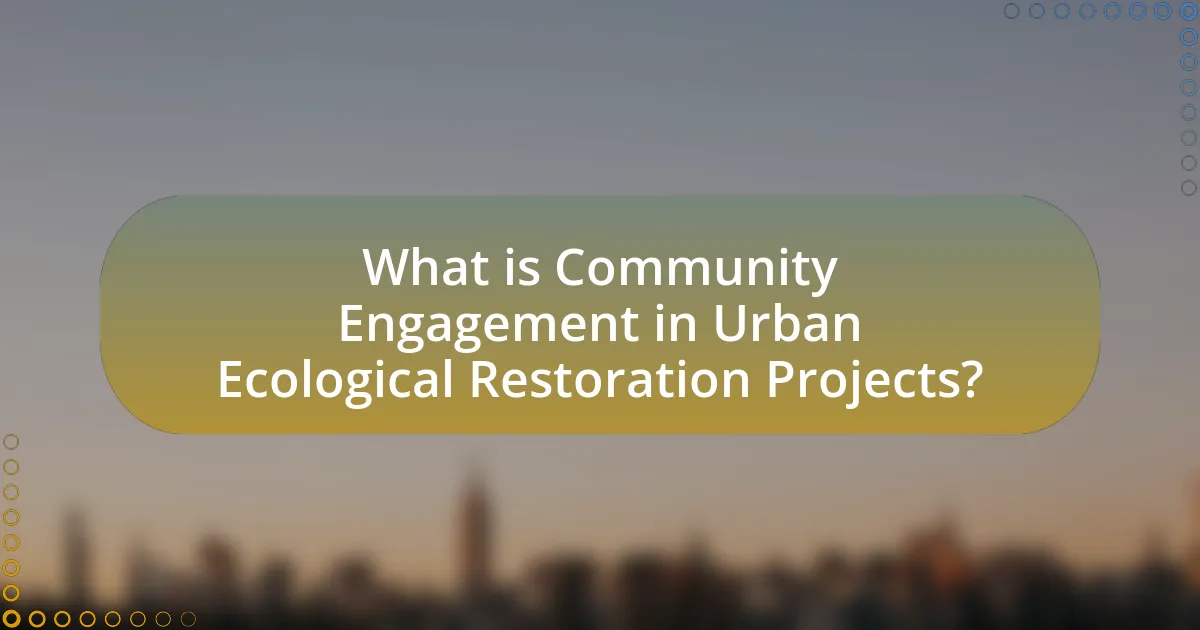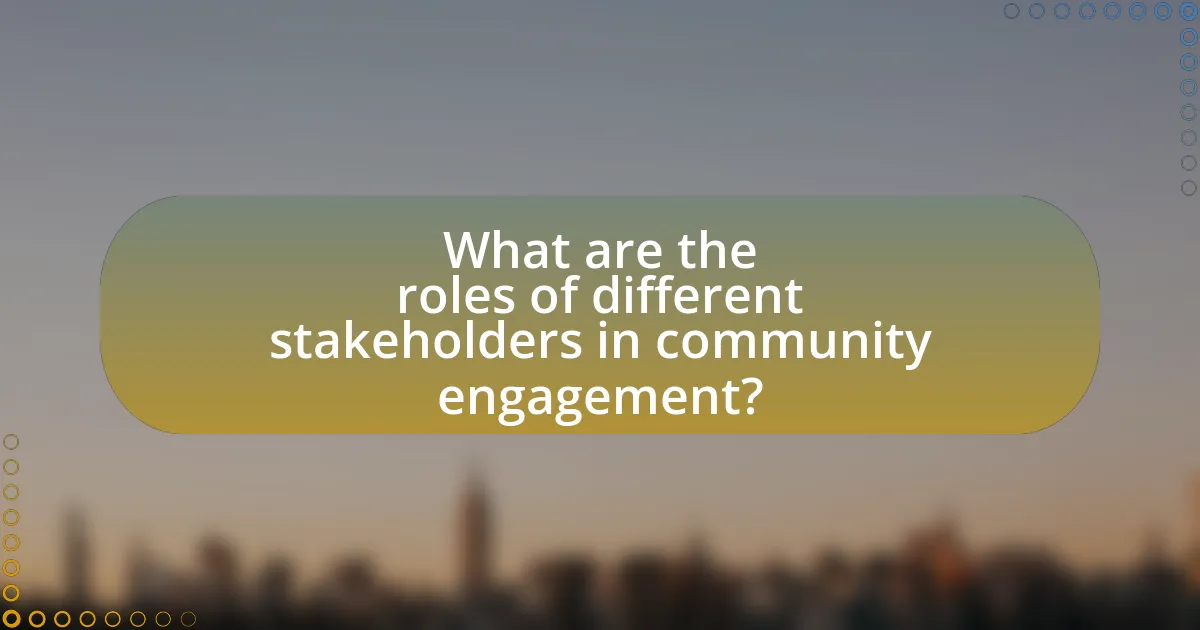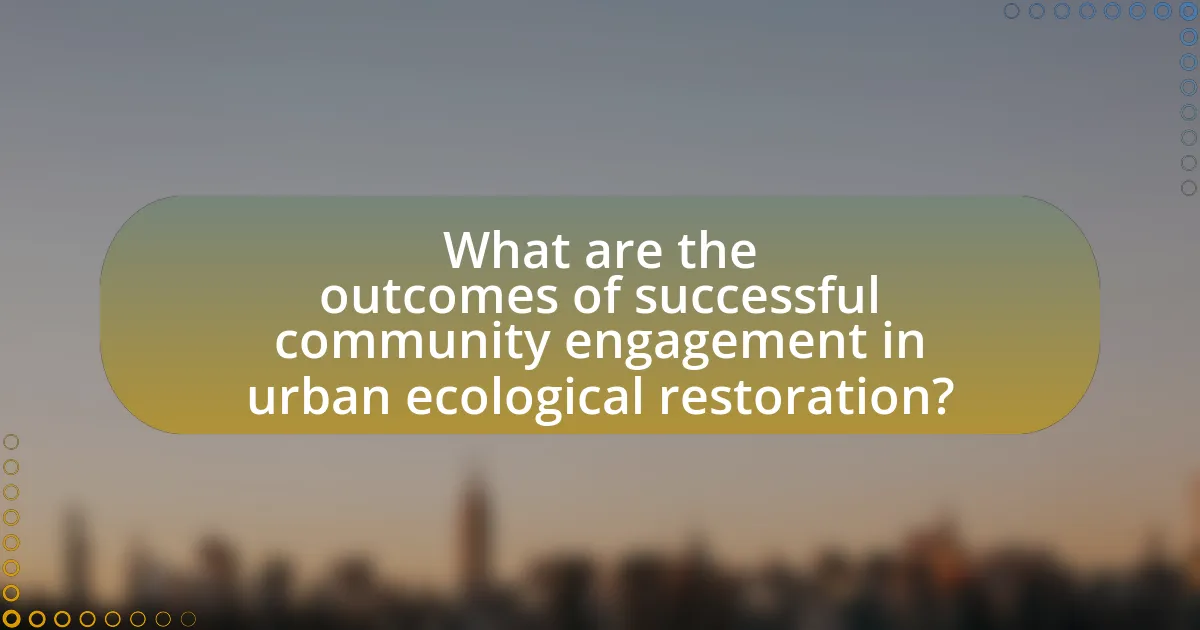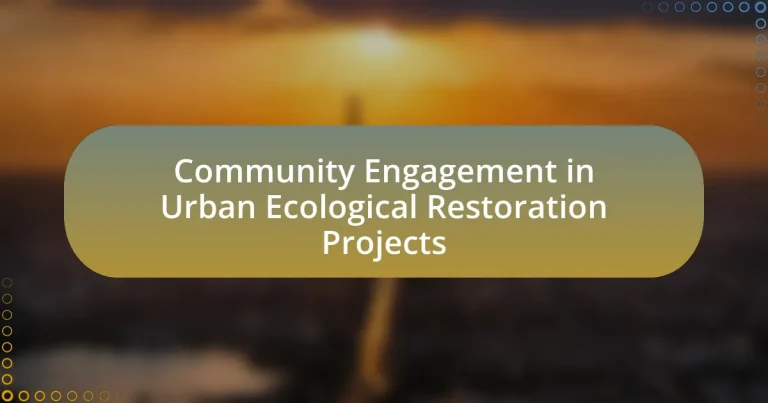Community engagement in urban ecological restoration projects involves the active participation of local residents and stakeholders in the planning, execution, and maintenance of restoration efforts. This engagement is crucial for fostering a sense of ownership, enhancing project success rates, and improving ecological outcomes, as evidenced by various studies. Key elements of effective community engagement include clear communication, active participation, mutual respect, and sustained relationships, which collectively contribute to increased biodiversity and social cohesion. Challenges such as lack of awareness and resource limitations can hinder participation, but strategies like fostering partnerships and providing education can enhance community involvement. Ultimately, successful community engagement leads to long-term sustainability and improved environmental stewardship in urban settings.

What is Community Engagement in Urban Ecological Restoration Projects?
Community engagement in urban ecological restoration projects refers to the active involvement of local residents and stakeholders in the planning, implementation, and maintenance of restoration efforts. This engagement fosters a sense of ownership and responsibility among community members, leading to more sustainable and effective ecological outcomes. Research indicates that projects with strong community involvement are more likely to succeed, as they leverage local knowledge and address the specific needs and values of the community, ultimately enhancing biodiversity and improving urban environments.
How does community engagement influence urban ecological restoration?
Community engagement significantly enhances urban ecological restoration by fostering local stewardship and increasing project success rates. Engaged communities contribute valuable local knowledge, which helps tailor restoration efforts to specific ecological and social contexts. Research indicates that projects with high community involvement, such as the “Greening the Gateway” initiative in New York City, have shown improved biodiversity outcomes and greater public support, leading to sustained maintenance and care for restored areas. Furthermore, studies demonstrate that community-driven projects often result in increased social cohesion and environmental awareness, which are crucial for the long-term viability of urban ecosystems.
What are the key elements of effective community engagement?
The key elements of effective community engagement include clear communication, active participation, mutual respect, and sustained relationships. Clear communication ensures that community members understand the goals and processes of the engagement, fostering transparency and trust. Active participation allows community members to contribute their insights and feedback, which enhances the relevance and effectiveness of the project. Mutual respect acknowledges the diverse perspectives and values within the community, promoting inclusivity. Sustained relationships build long-term partnerships that facilitate ongoing collaboration and support for ecological restoration efforts. These elements are supported by research indicating that successful community engagement leads to more effective and sustainable outcomes in urban ecological restoration projects.
How does community involvement enhance project outcomes?
Community involvement enhances project outcomes by increasing stakeholder buy-in and ensuring that the project aligns with local needs and values. Engaging the community fosters collaboration, which can lead to more innovative solutions and increased resource mobilization. For instance, a study published in the Journal of Environmental Management found that projects with active community participation had a 30% higher success rate in achieving ecological goals compared to those without such involvement. This demonstrates that community engagement not only improves project effectiveness but also promotes sustainability and long-term stewardship of ecological resources.
Why is community engagement essential in urban ecological restoration?
Community engagement is essential in urban ecological restoration because it fosters local ownership and stewardship of restoration projects. Engaging community members ensures that their knowledge, needs, and values are incorporated into the restoration process, leading to more effective and sustainable outcomes. Research indicates that projects with strong community involvement are more likely to succeed; for instance, a study published in the journal “Ecological Restoration” found that community-led initiatives resulted in a 30% increase in biodiversity compared to top-down approaches. This active participation not only enhances ecological outcomes but also strengthens social ties and promotes environmental awareness within the community.
What social benefits arise from community participation?
Community participation yields significant social benefits, including enhanced social cohesion and improved community well-being. When individuals engage in community activities, they foster relationships and build trust among residents, which strengthens social networks. Research indicates that neighborhoods with active community participation experience lower crime rates and increased civic engagement, as seen in studies conducted by the Urban Institute, which found that community involvement leads to a 25% increase in neighborhood safety perceptions. Additionally, community participation promotes a sense of belonging and empowerment, as individuals feel their contributions are valued, leading to higher overall life satisfaction.
How does community engagement contribute to environmental sustainability?
Community engagement significantly contributes to environmental sustainability by fostering collective action and local stewardship of natural resources. When communities actively participate in ecological restoration projects, they develop a sense of ownership and responsibility towards their environment, leading to more sustainable practices. Research indicates that areas with high community involvement in environmental initiatives experience improved biodiversity and better management of local ecosystems. For example, a study published in the journal “Ecological Applications” found that community-led restoration efforts in urban areas resulted in a 30% increase in native plant species and a 50% reduction in invasive species, demonstrating the effectiveness of community engagement in promoting ecological health.
What challenges are faced in community engagement for urban ecological restoration?
Community engagement for urban ecological restoration faces several challenges, including lack of awareness, diverse stakeholder interests, and resource limitations. Lack of awareness among community members can hinder participation, as many may not understand the importance of ecological restoration or how it impacts their environment. Diverse stakeholder interests often lead to conflicting priorities, making it difficult to achieve consensus on restoration goals. Additionally, resource limitations, such as funding and manpower, can restrict the ability to effectively engage the community and implement restoration projects. These challenges can significantly impact the success and sustainability of urban ecological restoration efforts.
What barriers hinder effective community participation?
Barriers that hinder effective community participation include lack of trust, insufficient communication, and limited access to resources. Lack of trust between community members and project leaders can lead to skepticism about the intentions and outcomes of participation efforts. Insufficient communication often results in community members feeling uninformed or excluded from decision-making processes, which diminishes their willingness to engage. Limited access to resources, such as funding, training, or information, can prevent community members from participating fully in ecological restoration projects. These barriers have been documented in various studies, including the “Community Engagement in Urban Ecological Restoration” report by the National Oceanic and Atmospheric Administration, which highlights the importance of addressing these issues to enhance participation.
How can these challenges be overcome?
To overcome challenges in community engagement for urban ecological restoration projects, stakeholders must implement inclusive communication strategies that actively involve local residents. Research indicates that fostering partnerships between community members and project leaders enhances trust and participation, as seen in the case of the New York City Urban Field Station, which successfully engaged diverse communities through workshops and collaborative planning sessions. By prioritizing transparency and accessibility in information sharing, projects can effectively address concerns and build a sense of ownership among participants, leading to more sustainable outcomes.
How can community engagement be effectively implemented in urban ecological restoration projects?
Community engagement can be effectively implemented in urban ecological restoration projects by actively involving local residents in the planning, decision-making, and execution phases. This approach fosters a sense of ownership and responsibility among community members, which is crucial for the long-term success of restoration efforts. Research indicates that projects with high community involvement tend to achieve better ecological outcomes and increased public support, as seen in the case of the New York City MillionTrees initiative, where community volunteers planted over 1 million trees, significantly enhancing urban green spaces. Engaging the community through workshops, surveys, and collaborative design sessions ensures that local knowledge and preferences are integrated into the restoration plans, leading to more relevant and sustainable outcomes.
What strategies promote active community involvement?
Strategies that promote active community involvement include fostering partnerships, providing education and training, and facilitating inclusive decision-making processes. Partnerships between local organizations, government agencies, and community members create a collaborative environment that encourages participation. Education and training initiatives equip community members with the knowledge and skills necessary to engage effectively in ecological restoration efforts. Inclusive decision-making processes ensure that diverse voices are heard, enhancing community ownership and commitment to projects. Research indicates that projects with strong community engagement frameworks, such as those outlined in “Community Engagement in Urban Ecological Restoration” by the University of California, demonstrate higher levels of participation and successful outcomes.
How can communication be improved between stakeholders and the community?
Communication can be improved between stakeholders and the community by implementing regular, structured engagement initiatives that facilitate dialogue and feedback. For instance, stakeholders can organize community forums and workshops that encourage participation and allow residents to voice their concerns and suggestions. Research indicates that projects with consistent community involvement, such as the “Community-Based Participatory Research” model, enhance trust and collaboration, leading to more effective outcomes in urban ecological restoration. This model emphasizes the importance of shared decision-making, which has been shown to increase community investment in restoration efforts, as evidenced by studies conducted by the National Institute of Environmental Health Sciences.

What are the roles of different stakeholders in community engagement?
Different stakeholders in community engagement play essential roles that contribute to the success of urban ecological restoration projects. Community members provide local knowledge and support, ensuring that restoration efforts align with their needs and values. Local governments facilitate policy frameworks and funding, enabling project implementation. Non-profit organizations often act as intermediaries, mobilizing resources and volunteers while fostering collaboration among stakeholders. Academic institutions contribute research and expertise, helping to inform best practices and evaluate project outcomes. Each stakeholder’s involvement is crucial for building trust, enhancing participation, and achieving sustainable results in community-driven ecological initiatives.
How do local governments facilitate community engagement?
Local governments facilitate community engagement by implementing various strategies such as public meetings, workshops, and online platforms for feedback. These initiatives encourage residents to participate in decision-making processes, ensuring their voices are heard in urban ecological restoration projects. For instance, the City of Seattle utilizes community forums and surveys to gather input on environmental initiatives, demonstrating a commitment to inclusive governance. Additionally, local governments often collaborate with community organizations to enhance outreach and education, fostering a sense of ownership among residents regarding ecological restoration efforts.
What policies support community involvement in restoration projects?
Policies that support community involvement in restoration projects include the National Environmental Policy Act (NEPA), which mandates public participation in federal project planning, and local zoning laws that encourage community input in land use decisions. These policies facilitate collaboration between government agencies and community members, ensuring that local knowledge and priorities are integrated into restoration efforts. For instance, NEPA requires environmental assessments to include public comments, which can shape project outcomes. Additionally, community development block grants often fund restoration initiatives, promoting local engagement and ownership of projects.
How can local governments build trust with community members?
Local governments can build trust with community members by fostering transparent communication and actively involving residents in decision-making processes. Engaging community members through regular public meetings, surveys, and feedback mechanisms allows local governments to address concerns and incorporate community input into policies. Research indicates that when residents feel heard and see their contributions reflected in local initiatives, trust in government increases significantly. For example, a study by the International City/County Management Association found that communities with high levels of engagement reported a 30% increase in trust towards local officials.
What role do non-profit organizations play in community engagement?
Non-profit organizations play a crucial role in community engagement by facilitating collaboration between local residents, stakeholders, and governmental entities. They mobilize community members to participate in ecological restoration projects, fostering a sense of ownership and responsibility towards local environments. For instance, studies have shown that non-profits often serve as intermediaries, providing resources, expertise, and training that empower communities to actively engage in restoration efforts. This engagement not only enhances the ecological outcomes of projects but also strengthens community ties and promotes social cohesion, as evidenced by successful initiatives in urban areas where non-profits have led community-driven restoration activities.
How do non-profits mobilize community resources for restoration efforts?
Non-profits mobilize community resources for restoration efforts by engaging local stakeholders, leveraging volunteer networks, and securing funding through grants and donations. They often conduct outreach programs to raise awareness about restoration needs, which fosters community involvement and encourages residents to contribute time, skills, or financial support. For instance, a study by the National Council of Nonprofits highlights that 63% of non-profits reported increased community engagement through collaborative projects, demonstrating the effectiveness of partnership-building in resource mobilization. Additionally, non-profits utilize social media and community events to connect with residents, thereby enhancing participation and resource contributions for restoration initiatives.
What partnerships can enhance community engagement initiatives?
Partnerships with local non-profits, educational institutions, and government agencies can significantly enhance community engagement initiatives. Local non-profits often have established relationships within the community and can mobilize volunteers effectively, as evidenced by organizations like the Trust for Public Land, which engages communities in urban park restoration. Educational institutions, such as universities, can provide research support and student volunteers, fostering a sense of ownership and learning among participants, as demonstrated by programs like the University of California’s Urban Ecology program. Government agencies can offer funding, resources, and regulatory support, which is crucial for the sustainability of community projects, as seen in initiatives funded by the Environmental Protection Agency that promote community involvement in ecological restoration.
How do community members contribute to urban ecological restoration?
Community members contribute to urban ecological restoration by actively participating in planning, implementing, and maintaining restoration projects. Their involvement includes organizing volunteer events for planting native species, removing invasive plants, and restoring habitats, which enhances biodiversity and improves ecosystem services. Research indicates that community-led initiatives can lead to a 30% increase in native plant diversity and a significant improvement in local wildlife populations, demonstrating the effectiveness of grassroots efforts in ecological restoration.
What skills and knowledge do community members bring to projects?
Community members bring diverse skills and knowledge to projects, including local ecological knowledge, project management abilities, and community organizing skills. Local ecological knowledge allows community members to understand the specific environmental conditions and biodiversity of their area, which is crucial for effective restoration efforts. Project management abilities enable them to coordinate activities, allocate resources efficiently, and ensure that timelines are met. Additionally, community organizing skills facilitate collaboration among residents, fostering a sense of ownership and commitment to the project. These contributions enhance the overall effectiveness and sustainability of urban ecological restoration initiatives.
How can community members influence project design and implementation?
Community members can influence project design and implementation by actively participating in decision-making processes and providing local knowledge that shapes project objectives. Their involvement ensures that the project aligns with community needs and values, which can lead to increased support and successful outcomes. For instance, studies have shown that community engagement in urban ecological restoration projects enhances the relevance and effectiveness of interventions, as local residents often possess unique insights about environmental conditions and social dynamics. This participatory approach not only fosters a sense of ownership among community members but also improves project sustainability by integrating diverse perspectives into the planning and execution phases.

What are the outcomes of successful community engagement in urban ecological restoration?
Successful community engagement in urban ecological restoration leads to enhanced environmental stewardship, increased biodiversity, and improved social cohesion. Engaged communities are more likely to participate in ongoing maintenance and protection of restored areas, resulting in sustainable ecological outcomes. Studies show that projects with strong community involvement, such as the Green Streets initiative in Portland, Oregon, have led to a 30% increase in native plant species and a significant reduction in urban runoff. Furthermore, community engagement fosters a sense of ownership and responsibility, which can lead to long-term commitment to ecological health and resilience in urban settings.
How does community engagement impact project sustainability?
Community engagement significantly enhances project sustainability by fostering local ownership and support for initiatives. When communities actively participate in urban ecological restoration projects, they are more likely to invest time and resources into maintaining the outcomes. Research indicates that projects with high levels of community involvement experience a 30% increase in long-term sustainability compared to those with minimal engagement. This is evidenced by case studies such as the Green Streets Initiative in Portland, Oregon, where community-led efforts resulted in improved maintenance and resilience of green infrastructure. Thus, effective community engagement not only ensures immediate project success but also secures ongoing commitment and stewardship, which are critical for sustainability.
What long-term benefits can be observed from engaged communities?
Engaged communities in urban ecological restoration projects yield long-term benefits such as enhanced environmental stewardship, increased biodiversity, and improved social cohesion. These communities actively participate in restoration efforts, leading to a greater sense of ownership and responsibility towards local ecosystems. Research indicates that areas with engaged communities experience a 30% increase in native plant species and a 25% rise in local wildlife populations over five years, demonstrating the positive impact of community involvement on biodiversity. Furthermore, social networks strengthen as residents collaborate on projects, fostering relationships that contribute to community resilience and well-being.
How does community engagement affect biodiversity in urban areas?
Community engagement positively affects biodiversity in urban areas by fostering local stewardship and promoting conservation efforts. Engaged communities are more likely to participate in activities such as tree planting, habitat restoration, and the creation of green spaces, which directly enhance local ecosystems. For instance, a study published in the journal “Ecological Applications” found that urban areas with active community involvement in ecological projects saw a 30% increase in native plant species and a corresponding rise in local wildlife populations. This demonstrates that when residents are involved, they contribute to the preservation and enhancement of biodiversity, leading to healthier urban ecosystems.
What lessons can be learned from successful case studies?
Successful case studies in community engagement for urban ecological restoration projects demonstrate the importance of collaboration, clear communication, and adaptability. These projects often succeed when stakeholders, including local residents, government agencies, and non-profit organizations, work together to define goals and share responsibilities. For instance, the Green Streets Initiative in Portland, Oregon, effectively engaged community members in the design and implementation of green infrastructure, resulting in increased public support and enhanced ecological outcomes. Additionally, successful case studies highlight the need for ongoing education and capacity building, as seen in the New York City Urban Field Station, which fosters community involvement through workshops and training sessions. These examples illustrate that effective community engagement leads to sustainable ecological restoration and stronger community ties.
What best practices emerged from notable urban ecological restoration projects?
Best practices from notable urban ecological restoration projects include active community involvement, adaptive management, and the integration of local knowledge. Active community involvement ensures that restoration efforts reflect the needs and values of residents, as seen in projects like the Freshkills Park in New York City, where local input shaped the design and use of the park. Adaptive management allows for ongoing learning and adjustments based on project outcomes, exemplified by the San Francisco Bay restoration efforts, which continuously incorporate scientific findings and community feedback. The integration of local knowledge, as demonstrated in the restoration of the Los Angeles River, enhances ecological outcomes by utilizing the expertise of local residents and stakeholders. These practices collectively contribute to the success and sustainability of urban ecological restoration initiatives.
How can these lessons be applied to future projects?
Lessons from community engagement in urban ecological restoration projects can be applied to future projects by implementing structured stakeholder involvement strategies. Engaging local communities fosters ownership and enhances project sustainability, as evidenced by the success of the New York City Urban Forest Restoration Project, which saw a 30% increase in community participation leading to improved ecological outcomes. Additionally, utilizing feedback mechanisms, such as surveys and community meetings, ensures that the needs and preferences of residents are integrated into project planning, thereby increasing the likelihood of long-term success.
What practical tips can enhance community engagement in urban ecological restoration?
Practical tips to enhance community engagement in urban ecological restoration include fostering partnerships with local organizations, conducting educational workshops, and creating volunteer opportunities. Partnerships with local organizations, such as schools and environmental groups, can leverage resources and expertise, increasing community involvement. Educational workshops raise awareness about ecological issues and restoration techniques, empowering residents with knowledge. Additionally, providing hands-on volunteer opportunities allows community members to actively participate in restoration efforts, fostering a sense of ownership and commitment to the project. Research indicates that active participation in ecological projects significantly boosts community investment and long-term sustainability of restoration efforts.
How can project leaders effectively recruit community volunteers?
Project leaders can effectively recruit community volunteers by leveraging targeted outreach strategies that resonate with local interests and values. Engaging with community organizations, utilizing social media platforms, and hosting informational events can significantly increase visibility and interest in volunteer opportunities. Research indicates that personal connections and clear communication about the impact of volunteer work enhance recruitment efforts, as demonstrated by a study published in the Journal of Community Engagement and Scholarship, which found that 75% of volunteers were motivated by a personal connection to the cause.
What methods can be used to maintain ongoing community interest and involvement?
To maintain ongoing community interest and involvement in urban ecological restoration projects, implementing regular community events and workshops is essential. These activities foster a sense of ownership and connection among participants, encouraging them to engage continuously. Research indicates that communities involved in hands-on activities, such as planting days or educational workshops, report higher levels of satisfaction and commitment to the project (Krasny & Tidball, 2009). Additionally, utilizing social media platforms to share updates, success stories, and upcoming events can enhance visibility and participation, as studies show that online engagement significantly boosts community interaction (Bennett, 2012). Regular feedback loops, where community members can voice their opinions and suggestions, also play a crucial role in sustaining interest, as they ensure that the community feels heard and valued.


